
Goal Zero Yeti 400 Review Summary
The Goal Zero Yeti 400 is a versatile solar generator designed for off-grid experiences and emergencies. Boasting an array of ports, it serves as a reliable power source for a myriad of devices, from mini-fridges to smartphones. A built-in LCD keeps you updated on its battery life and operations. It’s perfect for diving into the wilderness without missing a power beat!
PROS
Versatile with multiple charging ports (2 USBs, 1 12V, 2 AC outlets).
Noiseless operation ideal for quiet environments.
Can be charged through solar panels.
Useful LCD screen displays battery info and operations.
Operates efficiently within temperatures of 32-104°F.
Capable of powering various devices, from smartphones to mini-fridges.
CONS
Comes with only a single AC adapter; other accessories are sold separately.
Battery indicator displays only in 20% increments, lacking precision.
A short 6-month warranty raises durability concerns.
Battery capacity might not support larger electronic devices for long.
Goal Zero is one of the big names in eco-friendly tech, but is their Yeti 400 lead-acid power station really that good? As avid campers, we take a look at this power station.
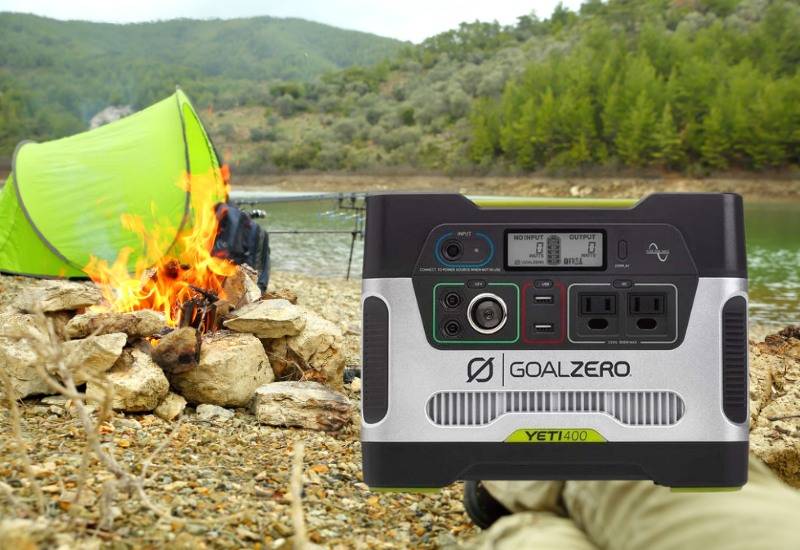
I love camping. However, as most campers know, spending extended periods of time in nature presents challenges unique to modern life.
The great explorers of the past didn’t have to worry about snapping pics for the ‘gram.
As such, I’ve been trying a lot of different portable power station units lately. Now, I’ve tried a few lithium power stations, but I thought this time I’d try a lead-acid power station on my quest for portable power.
I’m sick of my phone running outta juice while camping or during a blackout, so I thought I’d see if the Goal Zero Yeti 400 would fulfill my needs.
What Is The Goal Zero Yeti 400?
The Goal Zero Yeti 400 is a solar generator that uses a lead-acid battery to power your devices and electronics on a camping trip or if you’re living off-grid.
This lead-acid battery device can charge laptops, smartphones, tablets, lights, mini-fridges, and various other devices when you’re out camping, away from the grid, or during an emergency.
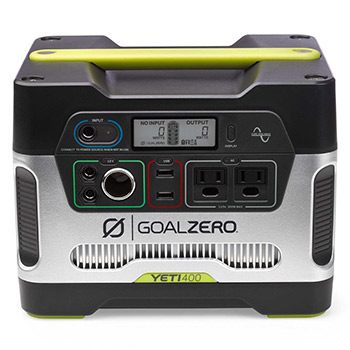
The Goal Zero Yeti 400 comes with multiple electronic ports for charging all different devices, including:
There is a fold-away carry handle for easy portability, and the LCD screen display tells you all the essential information you need to know at a glance. You can see both the input and output in watts, and you can also keep an eye on the battery level so you know when you’ve got a low battery approaching.
While 400W is a decent capacity for a portable power station, it’s worth noting that this product weighs a whopping 29 lbs, which is pretty heavy for a modern power station.
However, if you’re driving to a campsite and then leaving the Yeti in your tent, then it shouldn’t be a problem. But if you lug it around during an emergency, it can be.
How Long Does The Yeti 400 Last?
In practice, this battery has a 6-month shelf life and can last around 500 life cycles before reducing to 80% battery capacity.
The Yeti is powerful enough to charge:
If that sounds like enough juice for you, then this power station might be worth a shot.
What Can The Yeti 400 Power?
The Yeti 400 is good for charging smaller, everyday items that don’t have a huge power draw. It’s perfect for small appliances like mini-fridges, although you need to be mindful that they will drain the battery quite quickly.
Most people use these batteries for small digital devices like cameras, phones, and tablets while they’re in the great outdoors.
You could also use it as your home’s backup electricity generator, but it would only work for smaller devices.
Personally, I like to use the Yeti 400 to power my camping lights that keep my tent nice and visible. By the time I’ve powered by camping lights, charged my phone a few times, and charged my tablet a couple of times, I can normally get 2-3 days of use out of this thing.
How Do You Charge A Yeti 400?
You can charge a Yeti 400 in 3 main ways:
- Solar power (via a compatible solar panel kit)
- AC outlet (i.e. a regular home power outlet)
- 12V DC car charger (cigarette lighter slot)
How Long Does It Take To Charge A Goal Zero?
Depending on the charging method you choose, the amount of time it will take you to charge the battery will vary.
Results may vary slightly for different users and scenarios.
Goal Zero Yeti 400 Benefits
Can Be Eco-friendly
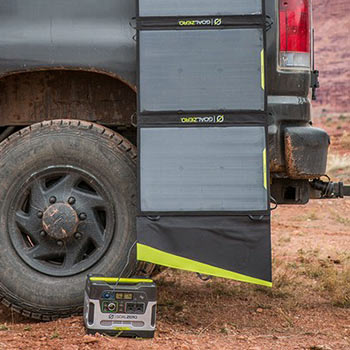
This being GreenCitizen and all, I'm obviously going to rave about any battery that is kind to Mother Earth. My reviews are almost always for products that are eco-conscious in some way.
You can charge this battery with a solar panel kit in about 9 hours on a good day, which is good if you don’t want to produce dangerous fumes or burn fossil fuels for your power.
Basically Silent
Some portable power stations can get a little noisy, especially if they’ve got fans to cool them down, but the Yeti 400 doesn’t make any noise at all.
This is ideal if you’re using it to charge devices while you’re sleeping nearby. However, the enormous weight of the battery cancels out this convenience for me.
Can Operate In High(ish) Heat
The Yeti 400 can operate in temperatures of around 32-104°F (0-40°C), which is more than enough temperature range for most people.
However, I do like to camp at the height of summer, and sometimes my tent can get very hot inside.
Now while I don’t think my tent has ever gotten to 104°F (40°C), it has gotten to the late 90s before now, which starts to make me a little nervous.
Goal Zero Yeti 400 Shortfalls
While this power station was enough for my basic camping needs, it wouldn’t be my first choice as a recommendation to people.
Sure, it’s a decent price and it does the job for many people’s needs, but there are many things about the Yeti 400 lead-acid version that is sure to influence people’s reviews.
It’s Really Friggin’ Heavy
It’s nice to know I’ve always got a backup light source in the woods with this.
But for something that’s going to charge my phone and my iPad a few times, this thing weighs A LOT. Now I understand that this is the cheaper lead-acid battery version, so it makes sense that it weighs a lot, but it’s still really infuriating.
For example, the lithium-ion battery version of the Yeti 400 comes in at just over 16 lbs, nearly half the weight. If you’re going to be moving this by long distances on foot, it’s not ideal.
It Doesn’t Come With Much
In the box, you get the Yeti 400 and then you get a single AC adaptor. That’s it.
I know that some people don’t need to use all the ports and slots on this power station, but it would be nice to have a couple of extra freebies thrown in.
I’ve had other power stations come with 12V DC car charger cables and other leads and extras thrown in, but this requires you to purchase all of that stuff separately.
It’s not the end of the world, but it’s annoying.
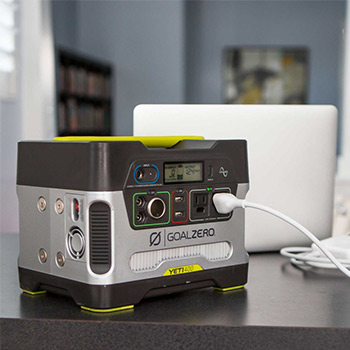
The Battery Indicator Is A Little Vague
The LCD display screen on the Yeti 400 comes with a battery indicator, but it’s a little vague, to say the least.
Basically, it shows you how much battery you have left in 20% chunks only.
So you can see whether the battery is between 0-20%, 20-40%, 40-60%, 60-80%, or 80-100%.
While I’m glad that there’s some indication of the battery level, most modern power stations like the Jackery Explorer 500 show you a specific percentage, so it feels a little outdated to be using a system like this.
The Warranty Is A Bit Short
The Yeti 400 power station comes with a 6-month warranty, which seems a little short for a product like this that costs several hundred dollars.
If you read many Yeti 400 reviews, a lot of people complain about how their power station broke just after the 6 months warranty was up, leaving them out of pocket.
That hasn’t happened to me yet, but I’m on the edge of my (outdoor) seat worrying about it.
Pros and Cons Summary of the Titan Solar Generator
Pros
Cons
Things To Consider Before Buying A Portable Solar Generator
Battery Type
Some battery types are cheaper than others, but that’s often because they weigh much more and have a lower capacity than their counterparts.
For example, the best power station units come with lithium-ion batteries, and these tend to be very light. However, you’ll pay for the privilege of such a good battery.
On the flip side, older types of batteries (such as a lead-acid battery) are cheaper but can weigh twice as much as lithium batteries. Are you willing to carry around a very heavy battery for the sake of a couple of hundred dollars?
Your Power Requirements
How much power do you actually need? There’s no point in buying a 2,000W huge power station if you just need to charge your phone a few times on a camping trip.
Consider all the electronic devices in your life that will need charging on a trip. Then, estimate how many times you will need to charge each device and do the math from there.
However, if you’re looking for backup power in your home during a blackout and you want to be able to use your fridge or freezer and other large appliances, you need a considerable amount of juice.
Solar Panels Charging
If you’re after a portable power station that can be charged with solar panels, then great! That’s good for the environment and we’re all about that here at GreenCitizen.
However, certain batteries only work with certain types of solar panel kits depending on their wattage. Make sure your power station is compatible with your solar panel kit.
Ports
If you’re just charging smartphones and tablets, then a few USB ports should do the trick for your needs.
However, if you want to use laptops, mini-fridges, small TVs, and other such appliances, you’re going to need an AC outlet with enough wattage to power your items.
FAQs
Yes, the Goal Zero Yeti 400 can power a small mini refrigerator for around 5-6 hours before losing power. However, if you want to power your home’s full-size fridge or freezer during a blackout, you’ll need a larger generator.
You cannot use just any solar panel with Goal Zero. Generally speaking, you need 100W solar panel kits specifically designed to charge portable power stations with the correct cables and inputs/outputs. Goal Zero makes their own solar panels that you can use.
Most Goal Zero solar panels are waterproof and designed to withstand the elements, but it’s always worth checking the manual just to be sure. However, the power stations themselves are often not waterproof.
Press and hold the 3 buttons labeled “Units,” “Light,” and “Info” for a few seconds until the screen blanks out. This should trigger a software reset and the product should power back on within a few minutes. If it doesn’t, plug it in with an AC charger to “wake it up.”
The Goal Zero Yeti 400: Should You Buy It?
While this power station was good enough to get me by on a camping trip, I wouldn’t recommend it to many people. I especially wouldn’t recommend it as backup electricity for your home — it’s just not powerful enough to cut the mustard.
I’ve also read many negative reviews and mixed reviews suggesting that it will die a painful death in the near future, so I’m scared to keep using it.
I cannot camp in fear!
If you need more power or just want a more reliable portable power station, I’d recommend the Jackery Explorer 500 instead.
If you need even more power than that, I’d also recommend the Jackery Explorer 1000 due to customer reviews and my own experience.
The Jackery 500 and 1000 units are made with a lithium-ion battery, so they’re much lighter, coming in at around 13 lbs and 22 lbs respectively.
This makes them much easier to carry if you’re taking them on long walks or hikes.
I mean, the Explorer 1000 has more than twice the capacity of the Yeti 400 and it weighs 7 pounds less.
The Jackery products also have extra features like built-in LED flashlights for emergencies - they’re very well-suited to campers and preppers. They also tell you the exact percentage level of their battery, so you know exactly how much juice is left before you run out.
If you’re a fellow camper, I’d say go for the Jackery 500 or Jackery 1000.

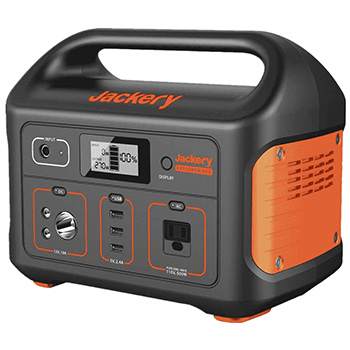









I have had a Yeti 400 for years now. I have added a second battery (sealed AGM battery same as in the yeti 400) and connected it via the Anderson power pole connection on the side making it a Yeti 800. I also have a 100W solar panel to charge it. The Yeti 12V input is regulated, so you need to NOT use the regulator on your solar panels if they have one. I was able to create an unregulated output from my solar panel and connect to the 12V input with an adapter from Goalzero. One con is the 12V outlet’s center connector is recessed. Some 12V auto adapters will not work with it, an example is my Dometic refrigerator. Goalzero sent me an adapter, that kind of fixes it, but another connect is another point of failure, it disconnects sometimes. Some Goalzero cables seem to be too lightweight and fragile, I take care not to damage them. The provided AC charger charges both the internal battery and the daisy-chained battery at the same time. The battery charger can get very hot when charging, Goalzero support said that was OK. I think the AGM version is fine, batteries are not very expensive and easy to replace. Lithium batteries can malfunction and catch fire. Another use of the Yeti 400 I have is to power my astrophotography setup on cold nights when smaller internal lithium batteries seem to fail. I can shoot all night with this setup.
Hi mate I’ve got a yetti 400 with a chained battery and a boulder 100 watt solar panel how to I add another 100 watt panel please
I’m so glad you found this helpful, It’s definitely eye-opening when you start learning about this stuff.
– Packaging was not reviewed. The GZ 400 is ruggedly packaged, important for the bumps common in camping trips. Such packaging typically adds weight.
– Battery replacement: The GZ 400 has several vendors offering a replacement battery priced under $100. Li power units cost hundreds for replacement batteries. Encouraging long term ownership reduces e-waste, so the total cost of long term ownership is a GZ 400 advantage.
– System Conservation: The GZ 400 has the option of turning the display OFF, saving a modest amount of drain over long periods of use.
This article and others also fail to explain that battery demand from inverter power is higher than from direct power. Example, my amateur radio equipment operates on 12vdc or 120vac power. Using the 12vdc mode eliminates the need for the inverter, further conserving available power, as the inverter electronics present an added drain in their function. Ditto for other appliances that have AC/DC power options: Eliminating wall nards in favor of auto chargers eliminates a redundant DC-AC conversion as well as energy wasting 12v-to-120v-to-12v (or 5v) conversion. While many power packs offer a range of output receptacles, these features are often reviewed as a convenience without suggestion of power drain conservation.
Fine regards –
Robert